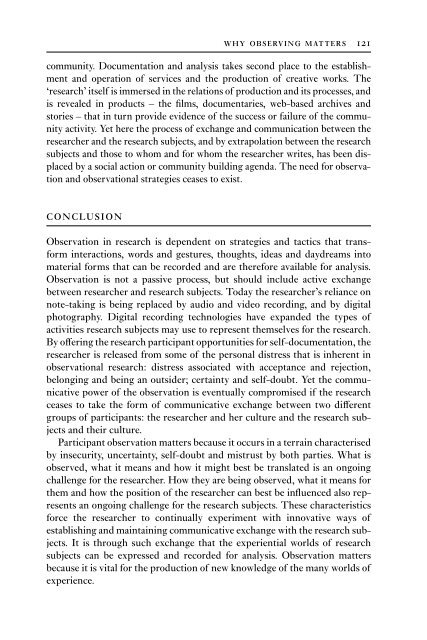Research Methods for Cultural Studies
Research Methods for Cultural Studies
Research Methods for Cultural Studies
Create successful ePaper yourself
Turn your PDF publications into a flip-book with our unique Google optimized e-Paper software.
community. Documentation and analysis takes second place to the establishment<br />
and operation of services and the production of creative works. The<br />
‘research’ itself is immersed in the relations of production and its processes, and<br />
is revealed in products – the films, documentaries, web-based archives and<br />
stories – that in turn provide evidence of the success or failure of the community<br />
activity. Yet here the process of exchange and communication between the<br />
researcher and the research subjects, and by extrapolation between the research<br />
subjects and those to whom and <strong>for</strong> whom the researcher writes, has been displaced<br />
by a social action or community building agenda. The need <strong>for</strong> observation<br />
and observational strategies ceases to exist.<br />
conclusion<br />
why observing matters 121<br />
Observation in research is dependent on strategies and tactics that trans<strong>for</strong>m<br />
interactions, words and gestures, thoughts, ideas and daydreams into<br />
material <strong>for</strong>ms that can be recorded and are there<strong>for</strong>e available <strong>for</strong> analysis.<br />
Observation is not a passive process, but should include active exchange<br />
between researcher and research subjects. Today the researcher’s reliance on<br />
note-taking is being replaced by audio and video recording, and by digital<br />
photography. Digital recording technologies have expanded the types of<br />
activities research subjects may use to represent themselves <strong>for</strong> the research.<br />
By offering the research participant opportunities <strong>for</strong> self-documentation, the<br />
researcher is released from some of the personal distress that is inherent in<br />
observational research: distress associated with acceptance and rejection,<br />
belonging and being an outsider; certainty and self-doubt. Yet the communicative<br />
power of the observation is eventually compromised if the research<br />
ceases to take the <strong>for</strong>m of communicative exchange between two different<br />
groups of participants: the researcher and her culture and the research subjects<br />
and their culture.<br />
Participant observation matters because it occurs in a terrain characterised<br />
by insecurity, uncertainty, self-doubt and mistrust by both parties. What is<br />
observed, what it means and how it might best be translated is an ongoing<br />
challenge <strong>for</strong> the researcher. How they are being observed, what it means <strong>for</strong><br />
them and how the position of the researcher can best be influenced also represents<br />
an ongoing challenge <strong>for</strong> the research subjects. These characteristics<br />
<strong>for</strong>ce the researcher to continually experiment with innovative ways of<br />
establishing and maintaining communicative exchange with the research subjects.<br />
It is through such exchange that the experiential worlds of research<br />
subjects can be expressed and recorded <strong>for</strong> analysis. Observation matters<br />
because it is vital <strong>for</strong> the production of new knowledge of the many worlds of<br />
experience.


